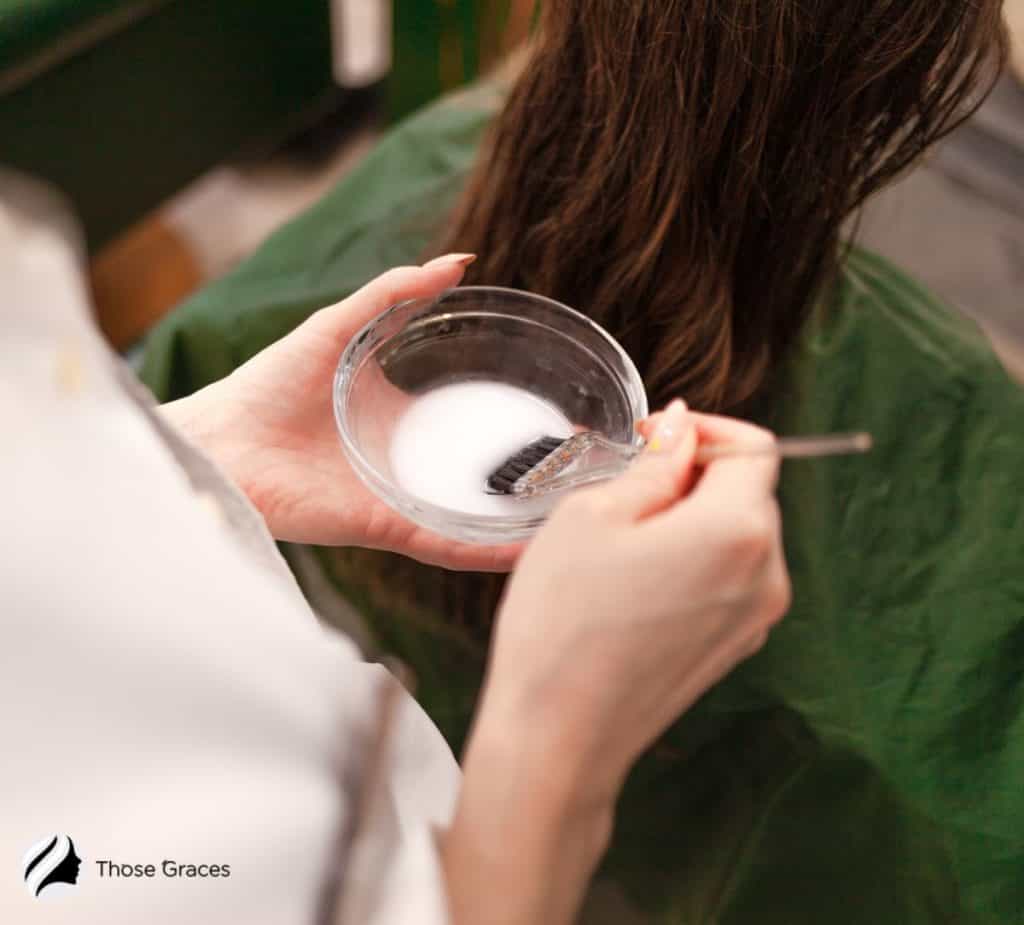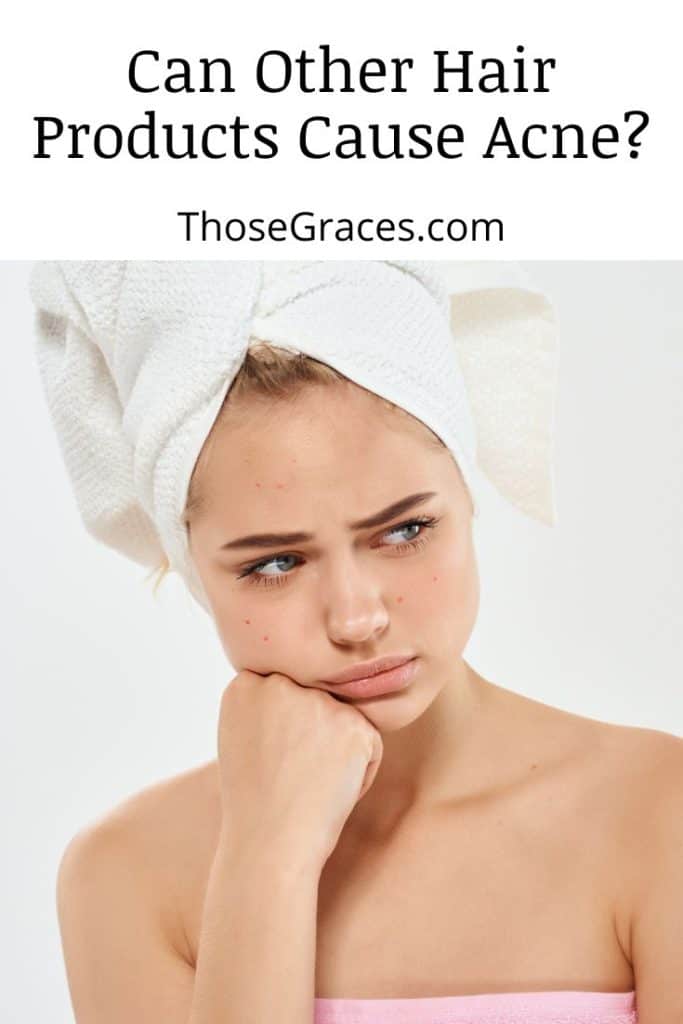Can keratin cause acne, and what can you do about it?
Keratin-based hair products are all the rave right now. After all, who doesn’t want hair products that make your hair smooth and frizz-free?
Unfortunately, keratin can cause acne, as I discovered when this happened to me after treatment, so I decided to dig deeper with research and spoke to my dermatologist.
Here’s everything I learned about keratin-related skin irritations and acne.
Let’s get started!
Table of Contents
Can Keratin Cause Acne?
Unfortunately, sometimes keratin can cause acne.
Keratin is not a foreign substance to the body. We were all born with it. However, some popular hair products have found a way to integrate this magic elixir into the ingredients. (1)
Surely your favorite hair salon offers these professional treatments which help make your hair smooth and shiny.
Unsurprisingly, a large number of people are in favor of these light treatments.

Shiny hair that lasts for over five months? Sign me up already! But these light treatments can compromise your healthy-looking skin.
Abnormal keratinization of the follicular infundibulum, i.e., overproduction of keratin, can cause acne vulgaris.
Excessive keratin leads to clogged pores in which dead skin cells are trapped. (2)
Dr. Caren Campbell says, “Dead skin cells clog the pore, and then oil, dead skin cells, product, and acne bacteria are all in the pore.” (3)
But how does hyper–keratosis, i.e., excess keratin happen at all? Chronic inflammation or an increment in body pressure can lead to extra keratin.
This type of acne shows up as white bumps on the outer layer of the skin. Sometimes they also appear on the upper arms, buttocks, and thighs. They can feel like scaly bumps.
While keratin treatments are risk factors for acne-prone and oily skin, even those with other skin types can get actinic keratosis.
There’s also the risk of keratin allergy, which you may want to read about in detail!
Ensure you’re informed about potential drawbacks with our insightful exploration into “Keratin Hair Treatment Side Effects” before your next salon visit.
Can Keratin Clog Pores?
Now that we have the answer to the question: can keratin cause acne? Let’s get to another important question. Does keratin clog pores? Well, yes!
Congested pores are one of the leading causes of acne. Normally, dirt from skin or sebum production clogs pores, but sometimes the culprit is an excess of keratin.

This may mean that your professional keratin straightener is leading to abnormal growths of protein in the layers of skin and making your acne worse.
Excessive keratin paired with dead skin cells leads to clogged pores. These prominent pores are scaly to the touch and are often white or skin-colored.
Some hair products can cause these prominent pores, but they can also be due to hormonal imbalance, skin irritation, or genetics.
Keratin acne and clogged pores are common skin disorders in children and teenagers. With time, these keratosis pilaris bumps disappear on their own. (4)
If they don’t, you may want to check your medical history and see it by a dermatologist.
Your dermatologist may prescribe topical acne or antibiotic medications to treat the acne from its source.
But frequent exfoliation can curb these growths of protein bumps and help you maintain your healthy-looking skin.
Physical scrubs can be pretty harsh on the layers of skin. Gentle exfoliation with acidic scrubs such as AHA, BHA, salicylic acid, or glycolic acid has been known to treat acne caused by hyper-keratosis.
Does keratin stop hair loss, though? Well, that’s another topic on keratin treatments that may be worth the read.
Discover a clearer, smoother skin journey as this comprehensive Dermatologist Treatment video takes you step by step through conquering Keratosis Pilaris:
Can Other Hair Products Cause Acne?
Now, let’s talk about other products that can cause acne.
1. Hair Waxes
Oil-based hair waxes can cause severe acne. Use water-based products instead.
2. Shampoo
Oil-based shampoos can break you out. NY dermatologist, Kally Papantoniou, says,
“Some shampoos contain oils—they can be olive, argon or coconut— that is pore-clogging, aka comedogenic.” (5)
3. Conditioners
Conditioners with ingredients such as silicone, petroleum, and cocoa butter can cause excess sebum production.
Another ingredient to avoid is panthenol which is quite common in conditioners.
Renee Rouleau, a celebrity esthetician, says, “ I have received tremendous feedback about how panthenol-free products have made drastic improvements to my client’s skin.” (6)
In short, avoiding harsh chemicals and oil-based products such as hair oil is best to ensure you don’t break out.
For anyone experiencing post-treatment changes, you should read my article “Hair Loss After Keratin Treatment.” It sheds light on potential causes and solutions. Don’t forget to check it out!
FAQs
What Are Keratin Pimples?
What Does Too Much Keratin Do To Your Skin?
How Do You Get Rid Of Keratin Pimples?
What Is Better, Smoothing Or Keratin?
Conclusion
I hope this article on can keratin cause acne was helpful to you. Any product that leads to the overactivity of oil glands can cause acne or even painful cysts.
You have to be careful of what you’re applying to your body and the kind of lifestyle you lead to maintain your physical health.

Did you ever get acne because of keratin? Let us know in the comments section!
Resources
- 1. Bragulla HH, Homberger DG. Structure and functions of keratin proteins in simple, stratified, keratinized, and cornified epithelia. Journal of anatomy [Internet]. Blackwell Science Inc; 2009;214:516–59. Available from: https://www.ncbi.nlm.nih.gov/pubmed/19422428
- 2. Kurokawa I, Nakase K. Recent advances in understanding and managing acne. F1000Research [Internet]. 2020;9:792. Available from: https://www.ncbi.nlm.nih.gov/pmc/articles/PMC7391011/
- 3. Livingston M. How to get rid of acne, according to a dermatologist [Internet]. CNET. Available from: https://www.cnet.com/health/personal-care/a-dermatologist-explains-why-you-get-acne-and-how-to-fix-it/
- 4. Keratosis Pilaris (KP) – Health Encyclopedia – University of Rochester Medical Center [Internet]. www.urmc.rochester.edu. [cited 2022 Sep 23]. Available from: https://www.urmc.rochester.edu/encyclopedia/content.aspx?contenttypeid=85&contentid=P00296
- 5. How to Tell If Your Shampoo Is Breaking You Out, According to Dermatologists [Internet]. NewBeauty. 2022 [cited 2022 Sep 23]. Available from: https://www.newbeauty.com/is-shampoo-breaking-you-out/
- 6. Nast C. Are Your Hair Products Making You Break Out? [Internet]. Teen Vogue. 2014 [cited 2022 Sep 23]. Available from: https://www.teenvogue.com/story/hair-products-cause-acne


